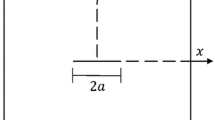Abstract
In this paper, we study the application of the method of fundamental solutions to the computation of stress intensity factors in linear elastic fracture mechanics. The displacements are approximated by linear combinations of the fundamental solutions of the Cauchy–Navier equations of elasticity and the leading terms for the displacement near the crack tip. The applicability of two formulations of the method is demonstrated on two mode I crack problems, where it is shown that accurate approximations for the stress intensity factors can be obtained with relatively few degrees of freedom.
Similar content being viewed by others
References
Atluri SN, (Ed.), (1986) Comput Meth Mech Fract, Elsevier Science Publishers, North-Holland, Amsterdam
Banerjee PK, Butterfield R (1981) Boundary element methods in engineering science. McGraw-Hill, Maidenhead
Barsoum RS (1976) On the use of isoparametric finite elements in linear fracture mechanics, Int J Numer Meth Eng 10:25–37
Barsoum RS (1977) Triangular quarter point elements as elastic and perfectly-plastic crack tip elements, Int J Numer Meth Eng 11:85–98
Berger JR, Karageorghis A (2001) The method of fundamental solutions for layered elastic materials. Eng Anal Boun Ele 25:877–886
Berger JR, Tewary VK (1997) Boundary integral equation formulation for interface cracks in anisotropic materials, Comput Mech 20:261–266
Burgess G, Mahajerin E (1984) A comparison of the boundary element and superposition methods, Comput Struct 19:697–705
Cruse TA (1988) Boundary Element Analysis in Computational Fracture Mechanics, Kluwer Academic Publishers, Dordrecht
Fairweather G, Karageorghis A (1998) The method of fundamental solutions for elliptic boundary value problems, Adv Comput Math 9:69–95
Fairweather G, Karageorghis A, Martin PA (2003) The method of fundamental solutions for scattering and radiation problems, Eng Anal Bound Ele 27:759–769
Fenner RT (2001) A force superposition approach to plane elastic stress and strain analysis, J Strain Anal 36:517–529
Garbow BS, Hillstrom KD, More JJ (1980) MINPACK Project, Argonne National Laboratory
Golberg MA, Chen CS (1996) Discrete projection methods for integral equations, Computational Mechanics Publications, Southampton
Golberg MA, Chen CS (1990) The method of fundamental solutions for potential, Helmholtz and diffusion problems. In: Boundary Integral Methods and Mathematical Aspects, ed. M. A. Golberg, WIT Press/Computational Mechanics Publications, Boston, pp. 103–176
Hartmann F (1981) Elastostatics. In: Progress in Boundary Element Methods, Vol. 1., ed. C. A. Brebbia, Pentech Press, Plymouth, pp. 84–167
Hulbert LE (1963) The numerical solution of two-dimensional problems of the theory of elasticity, Bulletin 198. Engineering Experiment Station, Ohio State University, Columbus, Ohio
Kitagawa T (1991) Asymptotic stability of the fundamental solution method, J Comput Appl Math 38:263–269
Karageorghis A (1992) Modified methods of fundamental solutions for harmonic and biharmonic problems with boundary singularities. Numerical Methods Partial Differential Equations 8:1–19
de Madeiros GC, Partridge PW, Brandao JO (2004) The method of fundamental solutions with dual reciprocity for some problems in elasticity, Eng Anal Bound Ele 28:453–461
Mahajerin E (1985) An extension of the superposition method for plane anisotropic elastic bodies, Comput Struct 21:953–958
Marin L, Lesnic D (2004) The method of fundamental solutions for the Cauchy problem in two-dimensional linear elasticity, Int J Solids Struct 41:3425–3438
Martin PA, Rizzo FJ (1989) On boundary integral equations for crack problems, Proc R Soc A 421:341–355
Mukhopadhyay NK, Maiti SK, Kakodkar A (2000) A review of SIF evaluation and modelling of singularities in BEM, Comput Mech 25:358–375
Numerical Analysis Group (NAG) (2001) Library Mark 20, NAG Ltd, Wilkinson House, Jordan Hill Road, Oxford, UK
Patterson C, Sheikh MA (1982) On the use of fundamental solutions in Trefftz method for potential and elasticity problems. In: Brebbia CA (ed) Boundary element methods in engineering. Proceedings of the 4th international seminar on boundary element methods. Springer, New York, pp 43–54
Poullikkas A, Karageorghis A, Georgiou G (1998) Methods of fundamental solutions for harmonic and biharmonic boundary value problems, Comput Mech 21:416–423
Pu SL, Hussain MA, Lorenson WE (1978) The collapsed cubic isoparametric element as a singular element for crack problems, Int J Numer Meth Eng 12:1727–1742
Raamachandran J, Rajamohan C (1996) Analysis of composite plates using charge simulation method, Eng Anal Bound Ele 18:131–135
Redekop D (1982) Fundamental solutions for the collocation method in planar elastostatics. Appl Math Model 6:390–393
Sanford RJ (2002) Principles of Fracture Mechanics, Prentice Hall, Upper Saddle River, New Jersey
Shah SP, Swartz SE, Ouyang C (1995) Fracture mechanics of concrete: applications of fracture mechanics to concrete, rock and other quasi-brittle materials. Wiley, New York
Smyrlis Y-S, Karageorghis A (2001) Some aspects of the method of fundamental solutions for certain harmonic problems. J Sci Comput 16:341–371
Snyder MD, Cruse TA (1975) Boundary-integral equation analysis of cracked anisotropic plates, Int J Fract 11:315–328
Srawley JE, Gross B (1967) Stress intensity factors for crackline loaded edge crack specimens, Materials Research and Standards, 7:155–162
Tada H, Paris P, Irwin G (1985) The stress analysis of cracks handbook, 2nd edn., Paris Productions Inc., St Louis
Author information
Authors and Affiliations
Corresponding author
Additional information
Parts of this work were undertaken while the first author was a Visiting Professor in the Department of Mathematical and Computer Sciences, Colorado School of Mines, Golden, Colorado 80401, U.S.A.
Rights and permissions
About this article
Cite this article
Karageorghis, A., Poullikkas, A. & Berger, J.R. Stress intensity factor computation using the method of fundamental solutions. Comput Mech 37, 445–454 (2006). https://doi.org/10.1007/s00466-005-0716-z
Received:
Accepted:
Published:
Issue Date:
DOI: https://doi.org/10.1007/s00466-005-0716-z



